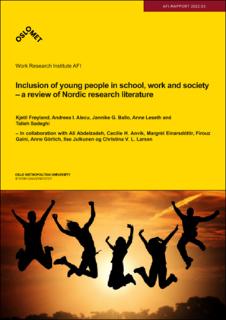| dc.description.abstract | In autumn 2019, the Norwegian Ministry of Labour and Social Inclusion and the Nordic Council of Ministers commissioned a literature review from the Centre for Work Inclusion (KAI) at OsloMet based on relevant Nordic research literature on vulnerable young people, exclusion and inclusion. Responsibility was assigned to a group of researchers at OsloMet/KAI who have collaborated with an external research group, reference group and user group, all comprising representatives from the Nordic countries/areas. A strategic literature search was conducted comprising a systematic search and subsequent identification of relevant studies based on input from the research group. A total of 84 studies were included. The main focus has been on studies from the social sciences on inclusion in work, school and society. The literature review identified many common challenges between the Nordic countries, but also contextual differences. The studies describe positive effects from various initiatives targeting vulnerable young people. We find consensus in the literature when it comes to what it takes to improve opportunities for inclusion. Facilitating good interaction, good relationships, establishing community arenas, providing sufficiently close individual follow-up by support personnel with inclusion competence and facilitating participation are all key factors. Factors at the structural level are also important, such as coordination and cooperation, flexible pathways through the education system, and parallel and simultaneous assistance and efforts. It is a key point that a certain continuity and duration of measures and efforts is required. We consider it a weakness in the effect studies from the Nordic context that they do not study inclusion as a phenomenon and that they are unclear about the effects of the various measures targeting vulnerable young people. | en_US |
